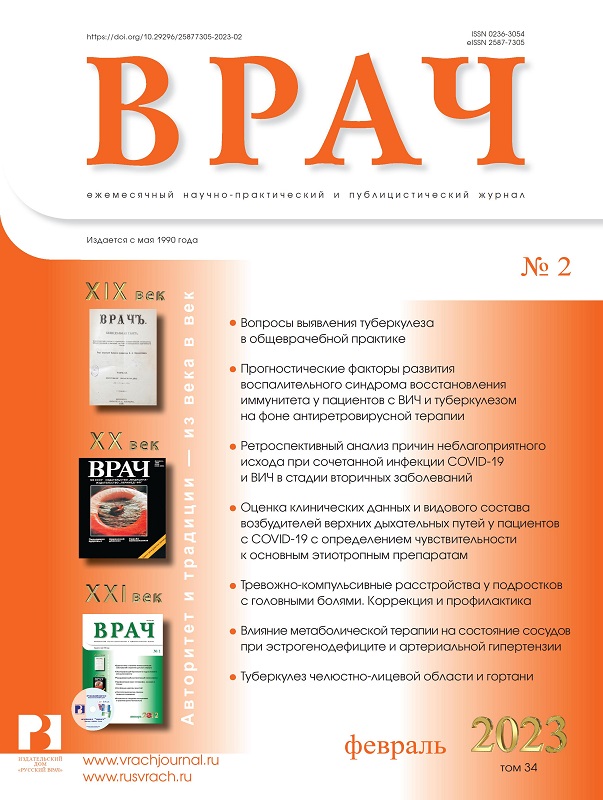Экспериментальное моделирование дефекта челюстных костей и анализ функциональной эффективности экзоскелета челюсти
- Авторы: Локтионова М.В.1, Габбасова И.В.2, Слетова В.А.2, Магомедова Х.М.3, Узденов Э.М.4, Захарян В.С.5, Слетов А.А.2,6, Адмакин О.И.1
-
Учреждения:
- Первый МГМУ им. И.М. Сеченова Минздрава России (Сеченовский Университет)
- Ставропольский государственный медицинский университет Минздрава России
- Дагестанский государственный медицинский университет Минздрава России
- Карачаево-Черкесская медицинская академия Минздрава России
- Кубанский государственный медицинский университет Минздрава России
- Ставропольская краевая клиническая больница
- Выпуск: Том 34, № 2 (2023)
- Страницы: 59-62
- Раздел: Из практики
- URL: https://journals.eco-vector.com/0236-3054/article/view/397565
- DOI: https://doi.org/10.29296/25877305-2023-02-14
- ID: 397565
Цитировать
Полный текст
Аннотация
В настоящее время моделирование дефектов челюстных костей после введения бисфосфонатных препаратов является актуальной задачей челюстно-лицевой хирургии. В экспериментальных работах все большую популярность приобретают методы виртуального моделирования патологических процессов и способов их устранения. Однако строго регулируемые законодательством медико-биологические исследования на экспериментальных животных не теряют своей актуальности. Выбор модели для нашего исследования основывался на предположении о том, что бисфосфонатный остеонекроз и дефект челюсти у экспериментальных животных идентичен клинической картине человека. Кроме того, в настоящем исследовании рассматривается разработка устройств для коррекции биомеханических нарушений и позиционирования фрагментов челюстных костей. Моделируемые субтотальные дефекты нижней челюсти сопровождаются ограничениями открывания рта, невозможностью адекватного приема пищи и, как следствие, угнетением привычной функциональной активности у экспериментальных животных. Это послужило основанием для включения в протокол оперативного вмешательства одномоментной фиксации фрагментов многофункциональным устройством – экзоскелетом нижнечелюстной кости. Положительная динамика в раннем послеоперационном периоде характеризовалась восстановлением биомеханического равновесия зубочелюстной системы. Полученные результаты обосновывают необходимость модернизации устройства и апробации экзоскелета у пациентов с субтотальными дефектами нижней челюсти.
Полный текст
Об авторах
М. В. Локтионова
Первый МГМУ им. И.М. Сеченова Минздрава России (Сеченовский Университет)
Автор, ответственный за переписку.
Email: Marinavrach@mail.ru
ORCID iD: 0000-0003-3555-2035
кандидат медицинских наук
Россия, МоскваИ. В. Габбасова
Ставропольский государственный медицинский университет Минздрава России
Email: Marinavrach@mail.ru
ORCID iD: 0000-0003-3850-4274
Россия, Ставрополь
В. А. Слетова
Ставропольский государственный медицинский университет Минздрава России
Email: Marinavrach@mail.ru
Россия, Ставрополь
Х. М. Магомедова
Дагестанский государственный медицинский университет Минздрава России
Email: Marinavrach@mail.ru
Россия, Махачкала
Э. М. Узденов
Карачаево-Черкесская медицинская академия Минздрава России
Email: Marinavrach@mail.ru
Россия, Черкесск
В. С. Захарян
Кубанский государственный медицинский университет Минздрава России
Email: Marinavrach@mail.ru
Россия, Краснодар
А. А. Слетов
Ставропольский государственный медицинский университет Минздрава России; Ставропольская краевая клиническая больница
Email: Marinavrach@mail.ru
ORCID iD: 0000-0001-5183-9330
доктор медицинских наук, профессор
Россия, Ставрополь; СтавропольО. И. Адмакин
Первый МГМУ им. И.М. Сеченова Минздрава России (Сеченовский Университет)
Email: Marinavrach@mail.ru
ORCID iD: 0000-0002-5626-2961
доктор медицинских наук, профессор
Россия, МоскваСписок литературы
- Басин Е.М. Токсические фосфорные некрозы лицевого черепа. Автореф. дисс. … д-ра мед. наук. М.: Первый МГМУ им. И.М. Сеченова, 2017; с. 36.
- Березов Т.Т., Маклецова М.Г., Сяткин С.П. и др. Роль обмена полиаминов в функциональной активности мозга в норме и при патологии. Журнал неврологии и психиатрии им. С.С. Корсакова. 2013; 113 (7): 65–70.
- Биохимия. Учебник. Под ред. Е.С. Северина. 2-е изд., испр. М.: ГЭОТАР-МЕД, 2004; с. 516–7.
- Гараева С.Н., Редкозубова Г.В. Постолати Г.В. Аминокислоты в живом организме. Кишинев, 2009; с. 68–85.
- Литвицкий П.Ф., Мальцева Л.Д. Нарушения обмена белков, аминокислот и нуклеиновых кислот. Вопросы современной педиатрии. 2015; 14 (1): 95–107.
- Михайлов В.В. Основы патологической физиологии. Руководство для врачей. М.: Медицина, 2001; с. 254–665.
- Петросян А.Л., Кутукова С.И., Чефу С.Г. и др. Сулодексид как выбор профилактики бисфосфонатного остеонекроза. Смоленский медицинский альманах. 2018; 4: 118–20.
- Полинг Л., Полинг П. Химия. М.: Мир, 1978; с. 389.
- Руководство по общей патологии человека. Учебное пособие. Под ред. Н.К. Хитрова, Д.С. Саркисова, М.А. Пальцева. М.: Медицина, 1999; с. 213.
- Эбзеев А.К. Бисфосфонатный остеонекроз челюстей у онкологических пациентов. Казанский медицинский журнал. 2020; 101 (2): 226–31. doi: 10.17816/KMJ2020-226
- Dunford J.E., Thompson K., Coxon F.P. et al. Structure-activity relationships for inhibition of farnesyl diphosphate synthase in vitro and inhibition of bone resorption in vivo by nitrogen-containing bisphosphonate. J Pharmacol Exp Ther. 2001; 296 (2): 235–42.
- Lee S.-H., Choi S.-Y., Bae M.-S. et al. Characteristics of patients with osteonecrosis of the jaw with oral versus intravenous bisphosphonate treatment. Maxillofac Plast Reconstr Surg. 2021; 43 (1): 24. doi: 10.1186/s40902-021-00310-w
- Schaffer S., Ha Won Kim. Effects and Mechanisms of Taurine as a Therapeutic Agent. Biomol Ther (Seoul). 2018; 26 (3): 225–41. doi: 10.4062/biomolther.2017.251
- Soma T., Iwasaki R., Sato Y. et al. Osteonecrosis development by tooth extraction in zoledronate treated mice is inhibited by active vitamin D analogues, anti-inflammatory agents or antibiotics. Sci Rep. 2022; 12 (1): 19. doi: 10.1038/s41598-021-03966-6
Дополнительные файлы






